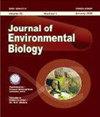Identification of bacterial endosymbionts in rice weevil, Sitophilus oryzae Linnaeus (Coleoptera: Curculionidae) populations of North India
IF 0.7
Q4 ENVIRONMENTAL SCIENCES
引用次数: 0
Abstract
Aim: The present study was undertaken to screen the most commonly occurring endosymbionts in S. oryzae populations from varied geographical regions of North India. Methodology: The six most common endosymbionts (Wolbachia, Arsenophonus, Spiroplasma, Rickettsia, Cardinium and Hamiltonella) were screened in 15 different populations of S. oryzae, representing five different agro-climatic zones of India. For this, the samples of S. oryzae were collected and identified using taxonomic keys and through PCR amplification of the COI gene followed by Sanger sequencing and comparison of obtained sequences with the NCBI database. Thereafter, the screening of endosymbionts was performed using 16S rRNA gene-specific primers for the respective endosymbionts. Results: The results showed the presence of Wolbachia and Spiroplasma in all 15 populations with infection rates of 100 and 85 per cent, respectively. Arsenophonus was detected in only 12 populations with 60 per cent infection rate. Concurrent infections of Wolbachia, Arsenophonus and Spiroplasma within the same individuals of S. oryzae were also detected. However, no infections of Cardinium, Rickettsia and Hamiltonella were found. Interpretation: Thus, it can be inferred that Wolbachia, Spiroplasma and Arsenophonus are the most common endosymbionts which can be exploited for the development of better management strategies against S. oryzae. Key words: 16S rRNA, Co-infection, Endosymbionts, Rice weevil, Sitophilus oryzae北印度稻象鼻虫(鞘翅目:虫科)种群中细菌内生体的鉴定
目的:本研究旨在筛选来自北印度不同地理区域的 S. oryzae 种群中最常见的内生菌。研究方法:在代表印度五个不同农业气候区的 15 个不同的 S. oryzae 种群中筛选了六种最常见的内生菌(沃尔巴奇菌、胂虫、螺原体、立克次体、红心菌和哈密尔顿菌)。为此,收集了 S. oryzae 的样本,并使用分类学密钥和 COI 基因的 PCR 扩增进行鉴定,然后进行 Sanger 测序,并将获得的序列与 NCBI 数据库进行比较。之后,使用 16S rRNA 基因特异性引物对内生菌进行筛选。结果显示结果显示,所有 15 个种群中都存在沃尔巴克氏体和螺浆虫,感染率分别为 100%和 85%。仅在 12 个种群中检测到胂虫,感染率为 60%。在 S. oryzae 的同一个体中还发现了同时感染 Wolbachia、Arsenophonus 和 Spiroplasma 的情况。但是,没有发现红心菌、立克次体和汉密尔顿菌的感染。解读:因此,可以推断出沃尔巴克氏体、螺原体和胂虫是最常见的内共生体,可以利用这些内共生体来制定更好的管理策略来防治口蹄疫。关键词16S rRNA 共感染 内共生体 稻象鼻虫
本文章由计算机程序翻译,如有差异,请以英文原文为准。
求助全文
约1分钟内获得全文
求助全文
来源期刊

Journal of environmental biology
ENVIRONMENTAL SCIENCES-
CiteScore
1.70
自引率
0.00%
发文量
92
审稿时长
3 months
期刊介绍:
Information not localized
 求助内容:
求助内容: 应助结果提醒方式:
应助结果提醒方式:


